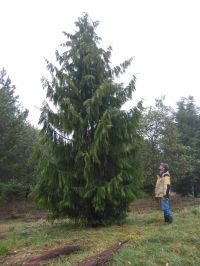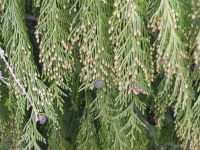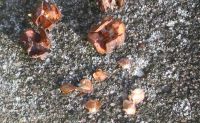Nootka cypress, Alaska-cedar - Callitropsis nootkatensis
English name:
Nootka cypress, Alaska-cedar
Scientific name:
Callitropsis nootkatensis (alias: Cupressus nootkatensis, Chamaecyparis nootkatensis, Xanthocyparis nootkatensis)
Family:
Cupressaceae (Cypress)
Height:
25 M in Denmark
Flowering:
April to early May in Hørsholm
Range:
northwest North America
 |
|
 |
 |
The 24 year-old Callitropsis nootkatensis in the pictures is from seed from the Vancouver Botanic Garden, British Columbia, Canada. This plant can be found to south of the large grass plain adjacent to Spejder sø in the area called Frihedslyst: square 2202, position 2534.
Plant description:
Which genus this species should be put into has been debated for some time. In recent years it was most often placed in the genus Chamaecyparis and given the name Chamaecyparis nootkatensis. This name you will still find on our plant tags while we wait for a general consensus within the botanical community. However, here I use the name: Callitropsis nootkatensis.
This species was originally thought to belong to the genus Cupressus, however, most accepted it as a species of Chamaecyparis based on the foliage. Nevertheless, the name Callitropsis nootkatensis was proposed in 1865 by the Danish botanist Anders S. Örsted, because this species had features with differed significantly for either of the other genera. This last proposal was largely forgotten until the exciting discovery in 2002 of a new species to science, which brought the naming problem to the forefront. Found in Vietnam, the new species was given the name Xanthocyparis vietnamensis. Because it is very closely related to this months plant, it was suggested that C. nootkatensis should be re-named Xanthocyparis nootkatensis. However a name was already proposed for a third genus, namely Callitropsis. The newly proposed name, Xanthocyparis will probably have to give way to the original Callitropsis and the newly found plant in Vietnam will probably also be given the old genus name. It is interesting to see that Prof. Örsteds old idea of placing of this plant in a new genus will become generally accepted. It sometimes takes a long time, but in science, correct ideas eventually prevail.
The genus Callitropsis contains 2 species; 1 from northwest North America and 1 newly discovered species from Vietnam. We have only the North American species in our collection. The new species from Vietnam would probably be impossible to grow outdoors in the Danish climate.
C. nootkatensis, was discovered in 1793 and introduction into Europe about 1850. It was perhaps first grown in Denmark in Krenkerup Garden in 1866 and in the Forest Botanic Garden in Charlottenlund as least as early as 1890. We have 16 specimens in the Arboretum in Hørsholm and 9 in our satellite garden, the Forest Botanic Garden in Charlottenlund. Interestingly one of the nine in Charlottenlund is a self-sown specimen, indicating that it is well enough adapted to the Danish climate to be able to reproduce itself. This species will also regenerate in its natural habitat by layering. It will form hybrids with at least 3 species of Cupressus but not with any Chamaecyparis species.
C. nootkatensis may be the longest living tree in Northwest North America and perhaps the oldest in Canada. Specimens with documented ages of over 1800 years have been reported and the probable age of some trees with hollow trunks is over 2000 years. Growth in its native habitat is often extremely slow and rather small trees can be 300 to 1000 years old. In the Arboretum in Hørsholm, growth has been considerably faster.
C. nootkatensis is a conical, evergreen, tree with scale-like leaves and often with striking foliage, hanging like curtains from the main branches. The bark changes from green to wine red and finally becomes brown and fibrous with stringy ridges that can be peeled away. The foliage occurs as pendulous sprays which hang down on both sides of the main branches. This habit is better developed on the upper part of the tree. The scale leaves occur in pairs with the lateral pairs largest. Male cones are 3 mm long with yellow stamens. The female cones are 1.2 cm in diameter when nearly mature, they are round, green changing to purple in colour, and have a small spike on each scale. They typically have only 4 scales per cone, unlike species of Chamaecyparis. As in the genus Cupressus they take two years to mature.
This is a strikingly beautiful tree with a dramatic architecture. There are 15 to 20 named cultivars. The commonest cultivar Pendula has very strongly hanging foliage. It has for good reasons been called the Afghan hound tree. Although well adapted in general to the cool, moist, Danish climate, it should be planted in a protected area away from strong winds. The tree is almost disease free.
References:
Burns, R.M. & Honkala, B.H. 1990. Silvics of North America Vol. 1, Conifers. USDA Agriculture Handbook 654. 675 pp.
Mitchell, A. & Ødum S. 1983. Træer i Nordeuropa (Trees in Northern Europe). Gads Forlag, Copenhagen, pp. 413pp.
Olsen, O. et al. 1997 Havens Planteleksikon. Træer og Buske. (Danish Plant Encyclopaedia, Trees & Bushes). Det Danske Haveselskab Publisher, 674 pp.
Poor, J.M. & Brewster, N.P. 1994. Plants that Merit Attention. Vol II. Trees. Timber Press Publisher.
Rushforth, K. 1999. Trees of Britain and Europe. Harper Collins Publisher. 1336 pp.
